
Once again, I'm sorry for posting this a day late; as you'll see, Sunday was a late night!
It occurs to me that I have given short shrift to the twin towns of Dunkeld and Birnam, where we have been staying. On the one day that we had free time set aside in the schedule to explore them (last Friday) Cheryl and I slept in, and we have not had a chance to make up for the omission. There are plenty of interesting things to see here, which many choir members have taken the time to search out. The Birnam Woods are the same ones that figure prominently in Shakespeare's "Macbeth," and not only is there an exhibition called "The Macbeth Experience" nearby but also there's the ancient Birnam Oak, which was there before Shakespeare's time. Dunkeld claims to have staged the first Highland Games in 1822; Caroline Rice's sister-in-law Vicki Hammer, whom we met Friday, has a shop called "Kettles of Dunkeld" where many choir members contributed to the local economy; and there's a "Beatrix Potter Gardens" right across the street from our hotel. Then there is the cathedral, about which more later.

Sunday morning after breakfast, we began with a rehearsal in the hotel's dining hall to clean up some rough places that we had noticed at our previous concerts. Then, since it was Sunday and we didn't have a place as a guest choir in a local church, Rev. Ray Lambert and Terri Breitling led us in a brief worship service, including communion, in the same dining hall before we hit the road.
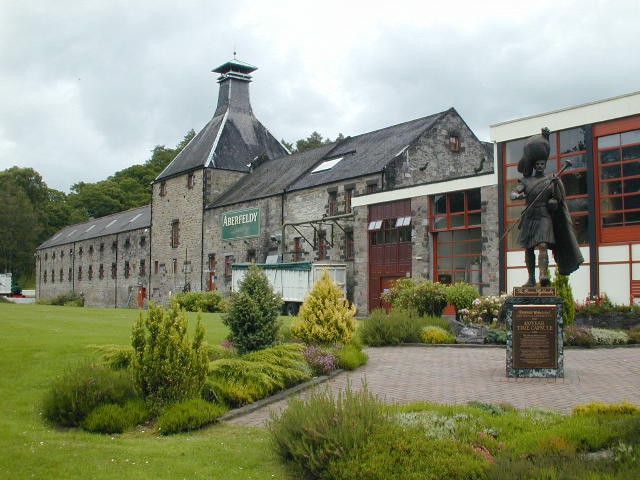
Actually, not all of us hit the road; I said above that Birnam and Dunkeld were interesting, and some of our folks decided to stay there and either rest or explore locally some more. Then we dropped off some others early at Pitlochry, our afternoon destination; but most of us went to the Dewar's whisky distillery in Aberfeldy. Since 1898, this is where they have made Aberfeldy single-malt Scotch whisky, which is the heart of the Dewar's White Label blended whisky. (I'm spelling it "whisky" rather than "whiskey" since that's what I saw written here; I guess the latter is an American spelling.) Dewar's White Label is a secret blend of up to 40 single-malt and single-grain whiskies; differences include (1) a single-malt whisky is made of malted (sprouted) barley, while a single-grain whisky can use other grains; (2) single-malt whiskies are distilled in batches, while single-grain whiskies are made by a continuous-distillation process; and (3) grain whisky has considerably stronger alcohol content and harsher flavor than malt whisky, which is why it is rarely found bottled separately but is instead the base for blended whiskies. By the way, 1986 marked the centennial of the first of many international awards won by Dewar's whisky, so under this statue of their Highlander symbol is a time capsule to be opened in 2086.
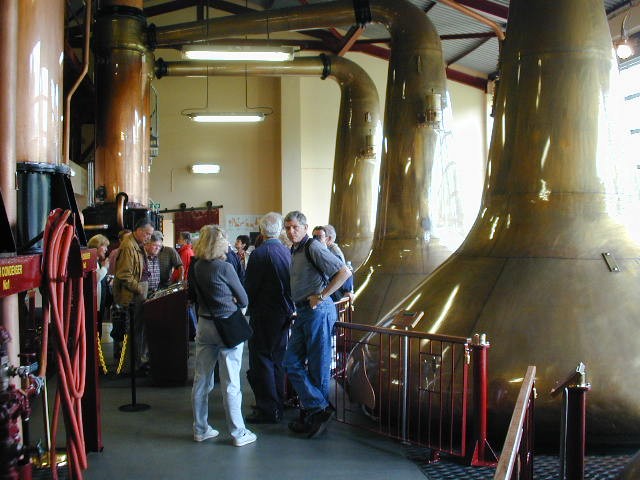
The process of making a single-malt whisky has relatively few steps; choice of ingredients and control of time and temperature, and finally selection of barrels for aging, make all the difference. All old Scottish distilleries were sited based on the availability of spring water nearby, and the Aberfeldy distillery is no exception; it takes a lot of water to make whisky! First you sprout the barley to increase sugar content, then dry and grind it. Then you wash it with progressively hotter water for several hours to dissolve the sugars. The sugar-laden water is called wort, and what's left is called draff; it's dried and sold to farmers as cattle feed. Yeast is then added to the wort and it is allowed to ferment for just over two days; the resulting "fresh wash" tastes like crude beer with about 8% alcohol content, and indeed the process so far has been much like beermaking. The next step is the departure: double distillation, first to 20% alcohol and then to 70%. The photo above shows the huge copper stills used for this process; looks like Noel Palm and Ron Koch are about to try their hands at the controls!
Distillation takes just a few hours per batch, so to go from dried malt to distilled spirits only takes about three days. Next, however, the spirits are put in barrels of Spanish oak, and aged for at least 12 years (the minimum for Scotch whisky is 3 years). The barrels are bought used from American whisky distilleries; it isn't just Scottish frugality that causes them not to buy new barrels, but rather the fact that new oak contains too much tannin and would spoil the flavor of the Scotch whisky. (By law, whisky in America must be aged in new barrels.) Barrels are reused twice; since that's at least 36 years plus whatever time the American whisky aged in them, that's a good long lifespan, during which each barrel produces several hundred bottles of whisky!

After the distillery tour, we had a little time to explore the exhibits in Dewar's World of Whisky. This contained everything from vintage advertising and packaging materials to a computer game where you could try to blend different whiskies to the satisfaction of an expert "nose," whose job is to oversee the consistency of each blend from batch to batch. Tommy Dewar, one of the founder's sons, was a sought-after public speaker, and many of his epigrams were written on the walls; familiar ones (that I didn't know were his!) include "Minds are like parachutes: they only function when they are open," and "The cockerel crows, but the hen delivers the goods." And, of course, no distillery tour would be complete without the opportunity to sample the product!
We got a rather late start, and took longer than expected at the distillery; thus those who hadn't gone to Pitlochry in the morning had just a brief time to explore it and to get lunch. The town was really "put on the map" by Queen Victoria, who loved vacationing there; besides shops and restaurants, some of our MBCC folks had a look at a gemstone factory, a Plant Collectors' Garden, and a hydroelectric plant with an innovative salmon ladder.
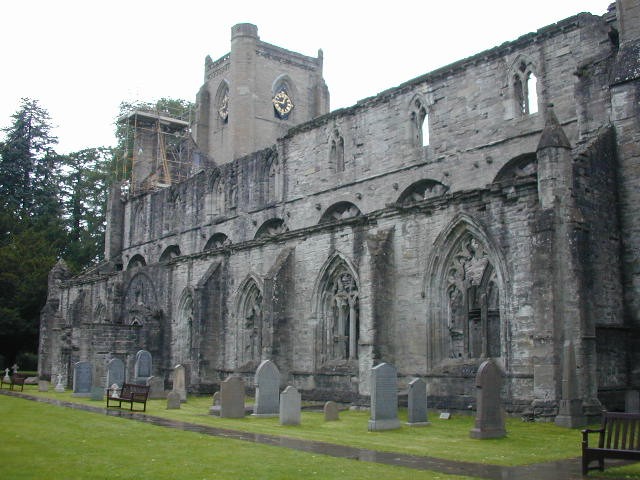
After our visits, short or long, to Pitlochry, we went back to the hotel to pick up the others, and then drove a little way down the road to Dunkeld Cathedral for a formal concert. The cathedral, like that in St. Andrews, had been trashed by a Protestant mob during the Reformation in the late 16th century; the chapterhouse attached to the cathedral (to the right of this photo) has been refurbished, and while the cathedral itself is in the care of the country's historical preservation organizations, the chapterhouse belongs to the Church of Scotland and is a functioning church.
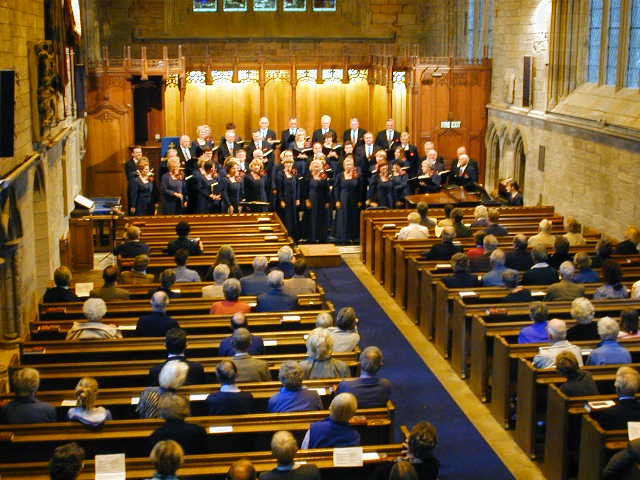
Here we are with a large audience (Caroline's family had gotten the word out, I think!) during our concert (photo by Steve Campbell with our digital camera). Robin Wylie, Caroline's nephew, began the second half of the concert by leading us in to the sound of his bagpipes; I dunno, I have about one finger's worth of Scottish blood in me, but the sound of the pipes always makes me stand up straighter! The audience was appreciative, and we spotted a number of people singing along with some of our songs, particularly our 1940's medley.
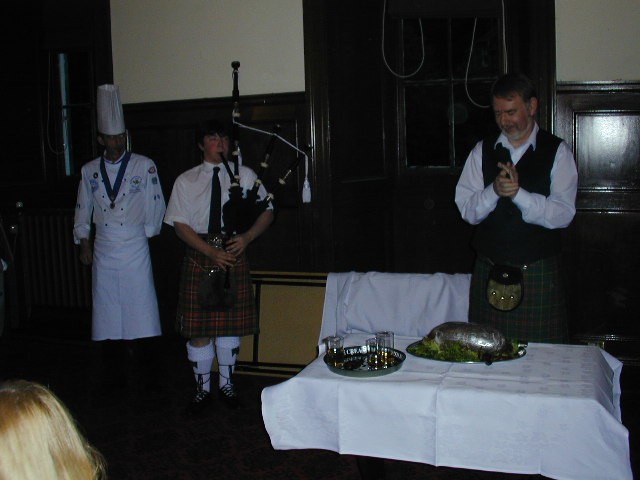
After we got back on the buses and returned to the hotel, we had a farewell dinner and entertainment. First they "piped in the haggis"; the chef carried in the haggis and marched it around the room to the sound of the pipes, and then the gentleman on the right recited Robert Burns' "Ode to a Haggis" and ceremonially stabbed the haggis with a dagger at the appropriate point in the poem. Then, as the meal was served, he picked up a guitar and, with an accordionist and (on some pieces) a singer, entertained us with Scottish music.
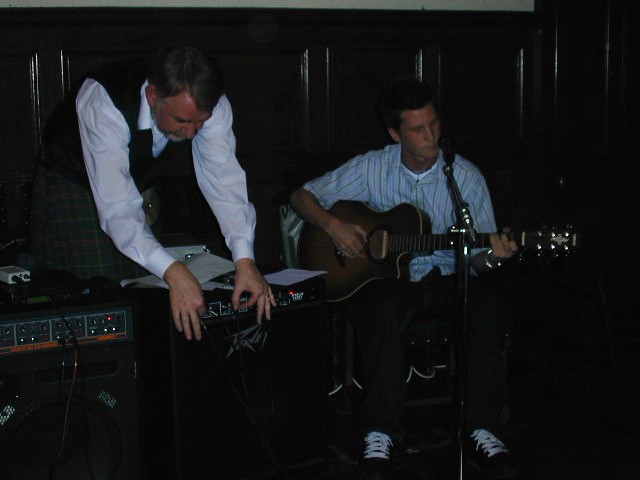
During some of the more lively pieces, Caroline did some Scottish country dances, and later others joined in (with greater or lesser skill!). Then during a break for the musicians, Roger Kuch went up to the stage with his guitar and played and sang a few numbers for us; after this the evening became sort of an "open mike" night, with folks from our tour group (including Jim Anderton, one of our drivers, and Peter Swann, one of our escorts) getting up to sing with the Scottish musicians in between the Scottish music. It was an enthusiastic, participatory celebration, and we didn't shut down until about midnight; so you can see why I packed it in without writing up the webpage for this busy day first!
 To
Monday, 8 July 2002
To
Monday, 8 July 2002 Back
to choir tour itinerary
Back
to choir tour itinerarynew 8 July 2002, revised 21 July 2002